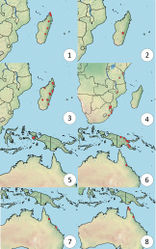Dichoteleas rugosus
| Notice: | This page is derived from the original publication listed below, whose author(s) should always be credited. Further contributors may edit and improve the content of this page and, consequently, need to be credited as well (see page history). Any assessment of factual correctness requires a careful review of the original article as well as of subsequent contributions.
If you are uncertain whether your planned contribution is correct or not, we suggest that you use the associated discussion page instead of editing the page directly. This page should be cited as follows (rationale):
Citation formats to copy and paste
BibTeX: @article{Schwartz2023ZooKeys1182, RIS/ Endnote: TY - JOUR Wikipedia/ Citizendium: <ref name="Schwartz2023ZooKeys1182">{{Citation See also the citation download page at the journal. |
Ordo: Hymenoptera
Familia: Scelionidae
Genus: Dichoteleas
Name
Dichoteleas rugosus Kieffer – Wikispecies link – Pensoft Profile
- Dichoteleas rugosus Kieffer, 1907: 297 (original description); Kieffer, 1926: 351 (description, keyed); Dodd, 1926: 370 (description); Masner, 1965: 72 (type information); Galloway, 1976: 90 (type information); Johnson, 1992: 367 (catalogued, type information).
- Dichoteleas pappi Szabó, 1971: 319 (original description); Galloway 1976[1]: 90 (type information); Johnson, 1992: 367 (catalogued, type information), new synonymy.
Description
Color of head: black. Hyperoccipital carina: absent. Frontal depression: absent. Malar striae: present. Facial striae: present. Setation of eyes: absent. Sculpture of frons: smooth above interantennal prominence, areolate laterally. Setation of frons: sparsely setose throughout. Submedian carina: absent. Interantennal process: undifferentiated. Central keel: absent. Transverse pronotal carina: present. Color of pronotum: dark brown to black. Pronotal cervical sulcus: present. Mesepimeral sulcus: present. Sulcus along mesopleural carina: foveolate. Mesoscutal suprahumeral sulcus: absent. Mesoscutal humeral sulcus: present, foveolate. Median mesoscutal line: absent. Color of mesoscutum: dark brown to black. Sculpture of mesoscutum: punctate with longitudinal striations between notauli. Notaulus: complete. Visibility of notaulus: unobscured. Parapsidal line: present. Sculpture of mesoscutellum: punctate. Shape of axillular carinae in lateral view: without a posteroventral hooklike projection. Color of axillular carina: brown. Sculpture of T3–6: rugulose and finely punctate. Median carina on T1–T4: absent.
Diagnosis
Dichoteleas rugosus can be distinguished from D. striatus by its setose and punctate mesosoma and other Dichoteleas by its bidentate mandibles.
Distribution
Australia (Queensland).
Material examined
Holotype, male, D. rugosus: Australia: QLD, Mackay; OCT-1897, B.M. TYPE HYM. 9.496.; Australia: 4 females, 2 males, OSUC 367523, 367536 (ANIC), OSUC 875046–875047, 875871–875872 (CNCI).
Comments
In the original description, Kieffer (1907)[2] wrote that D. rugosus was missing parapsidal lines. They are present but obscured by the sculpture of the mesoscutum.
Taxon Treatment
- Schwartz, J; Van Noort, S; Johnson, N; 2023: A taxonomic revision of the Old World genus Dichoteleas Kieffer (Hymenoptera, Scelionidae) ZooKeys, 1182: 183-205. doi
Images
|
Other References
- ↑ Galloway I (1976) the types of Australian species of the subfamily Scelioninae (Hymenoptera: Scelionidae).Queensland Journal of Agricultural and Animal Sciences33(1): 83–114.
- ↑ Kieffer J (1907) Beschreibung neuer im British Museum zu London aufbewahrter Proctotrypiden.Berliner Entomologische Zeitschrift51: 279–302. https://doi.org/10.1002/mmnd.47919060306

